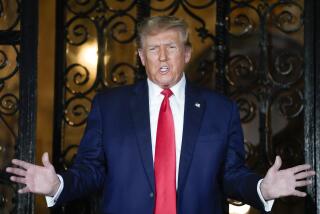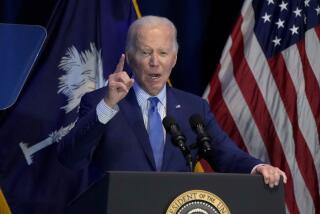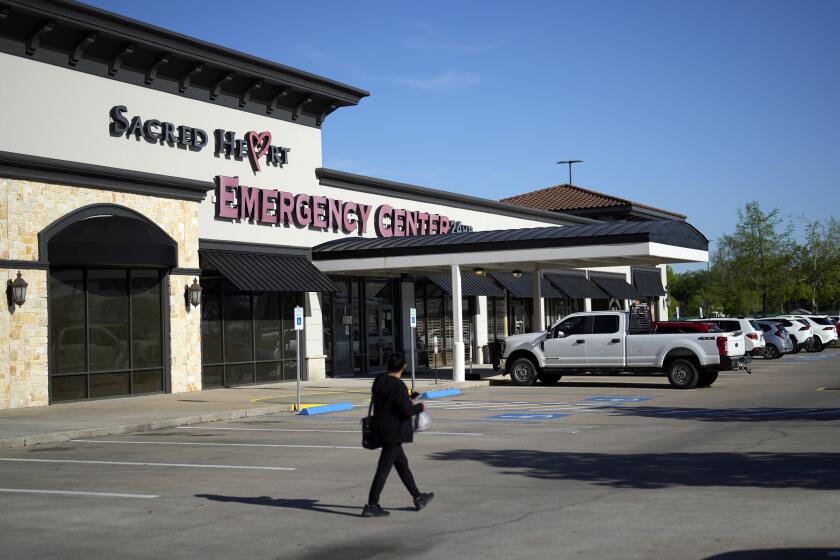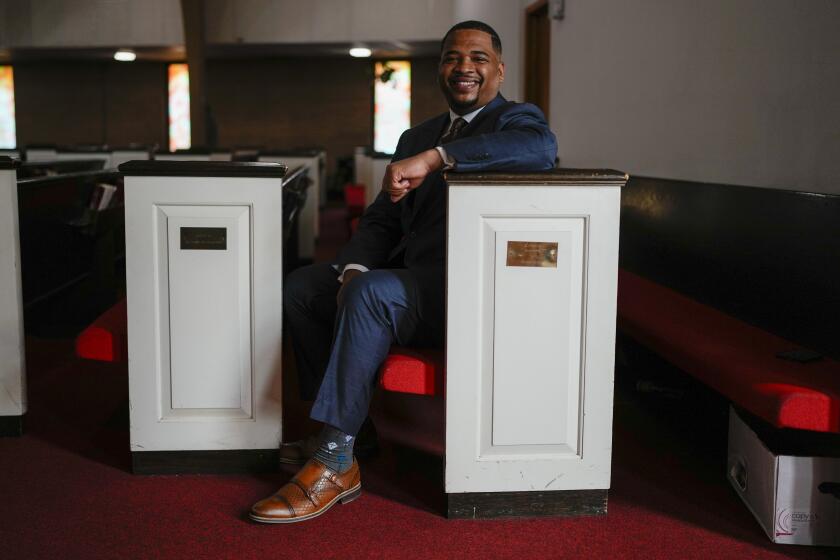Trump at the 100-day mark: Stable support but few achievements

Trump’s first 100 days in office are almost up. (April 26, 2017) (Sign up for our free video newsletter here http://bit.ly/2n6VKPR)
As his first 100 days in office draw to a close on Saturday, President Trump cannot claim many solid accomplishments, but does have one big one: He has held onto the support of the voters who put him in the White House.
Trump has dominated the daily news cycle and conversation like few of his predecessors. Questions abound about whether he can manage the White House, sustain focus on a policy debate or set strategy for international relations, but he has amply proved he can grab and hold the spotlight.
Partly because of that, his biggest influence so far may be the emotional effect he has had on the country. With Trump on center stage, Republican confidence in the nation’s future and the state of its economy has increased sharply. On the other side of the partisan divide, he has mobilized and energized Democrats to a level not seen in years.
And in many immigrant communities, Trump’s rhetoric has generated fear and anxiety that likely have contributed to a drop in the number of people trying to illegally cross the border.
Trump’s substantive impact so far looks small by comparison. Divisions within his party and opposition from Democrats have combined with his own errors to limit his effectiveness.
“Trump has focused on winning the short-term news cycle” every day, said UCLA political science professor Lynn Vavreck. “That’s an unusual strategy for someone governing.”
“Most people who want to be president of the United States have some long-term vision and want to lead to achieve that vision,” she said. Trump, so far, has not set out that kind of goal, she said.
Despite that, Democrats who believed Trump’s support might crumble quickly have had their hopes dashed by the steadfastness of the president’s backers.
As a result, the opening act of Trump’s presidency has unfolded as a high-decibel stalemate — one that a starkly polarized electorate has watched with rapt fascination.
A new USC Dornsife/Los Angeles Times “Daybreak” poll provides evidence of both the polarization and the stability of Trump’s support.
Well over 90% of people nationwide who voted for Trump in November said they would do so again.
But the poll, which in the fall consistently forecast that Trump would win the election, found that just 40% of Americans approved of his job performance; 46% disapproved, and 14% picked neither option.
More than a third, 35%, voiced strong disapproval of Trump, compared to 19% who strongly approved of him.
The survey was taken April 12-25 and questioned 3,039 Americans, of whom 2,584 reported that they had voted in the 2016 election. It has a margin of error of 2 percentage points in either direction.
The poll’s findings on Trump’s job approval echo surveys by other news organizations and nonpartisan polling groups. All have found approval of the president hovering around 40% — far less than any other elected president at this point in his tenure.
Americans split similarly on whether they like Trump personally: 37% said they do, 63% said they don’t, the poll found. About 1 in 6 of his own voters said they don’t like Trump personally, but approve of his policies.
In addition to the late April survey, the USC pollsters surveyed people in March. A comparison of the two shows something of a paradox: Among Trump’s voters, approval of his job performance has solidified even as doubts about him have begun to creep in.
In the earlier survey, about a third of Trump’s backers offered a wait-and-see answer when asked if they approved of Trump’s performance in office. By late April, their approval had firmed up, and 85% of those who voted for Trump now say they approve of his work.
But when asked whether “keeps his promises” was a phrase that applied to Trump, the results showed increased doubt. Between April and March, the share of Americans who said that Trump does keep his promises fell from 60% to 53%.
Among his own supporters, a significant number shifted from saying that keeping his promises “entirely applies” to the president to a more tentative “mostly applies.”
That decline squares with the evidence, if not with Trump’s own rhetoric.
Trump, in recent comments, has tried to brush aside many campaign promises. Asked in an interview with the Associated Press about the detailed Contract with the American Voter that he released in the closing weeks of the campaign, along with a speech, in Gettysburg, Pa., Trump sought to distance himself from the pledges.
“Somebody put out the concept of a hundred-day plan,” he said. “I’m mostly there on most items.
“But things change,” he added. “There has to be flexibility.”
In truth, Trump’s isn’t mostly there. Of 30 major promises Trump made during his campaign, a survey by The Times found only five that had been fulfilled so far. Many more have been scaled back and a few abandoned outright.
“There are not the usual accomplishments presidents like to point to,” said Julia Azari, a political scientist at Marquette University in Wisconsin who studies the presidency.
Trump has appointed Neil M. Gorsuch, a conservative justice, to the Supreme Court to replace the late Antonin Scalia — a key promise for many of the conservative voters who backed him in November. Gorsuch joined the high court this month.
Trump formally pulled the U.S. out of the proposed Trans-Pacific Partnership trade deal, a largely symbolic move since the agreement was already doomed in Congress. And he put in place several promised ethics requirements for his staff, although the White House already has begun giving some people waivers from some of the restrictions.
After that, the record is sparse.
Despite his party’s control of both houses of Congress and by contrast to the past three presidents, Trump has no big, early legislative accomplishments to point to. He has signed a number of bills, but all are small-scale measures, mostly to overturn regulations adopted in the final months of the Obama administration.
Many pieces of legislation Trump promised to introduce within his first 100 days remain nowhere in sight.
Divisions among Republicans in Congress have stymied his efforts to repeal President Obama’s healthcare law, which was a central promise not only of Trump’s campaign, but of all Republican campaigns since the law first passed in 2010.
He promised a major tax overhaul, but his administration has not fleshed out a tax plan, and on Capitol Hill, House and Senate Republicans disagree sharply on an approach. Trump has ballyhooed a “big announcement” on taxes for this week, probably Wednesday. But administration officials have cautioned that the president will be “outlining principles” for a tax plan, not releasing many specifics.
Trump’s proposal for a $1-trillion plan to increase spending on roads, bridges and other infrastructure has also yet to materialize.
White House officials defend the record.
“When you look at the number of pieces of legislation, the executive orders, business confidence, the place -- the U.S. role in the world, there’s a lot that we feel -- a lot of accomplishments that have occurred, and we feel very good about what we’ve done as we head up to this first hundred days,” White House Press Secretary Sean Spicer said Monday.
At the same time, however, Spicer and others have tried to downplay the 100-day measure, calling it an “artificial number that gets thrown out.”
There’s little question that other presidents have achieved more in their early days. In 2001, Congress passed President George W. Bush’s major tax cut in May. Obama won approval of his economic stimulus plan within his first 100 days, as well as a number of smaller-scale, substantive measures.
One of the biggest factors limiting Trump’s effectiveness — especially his ability to put forward ambitious legislative plans — has been his failure to staff key positions in his administration. Trump often blames Democrats for obstructing his nominees, but a much bigger part of the problem has been his own failure to name people.
The nonpartisan Partnership for Public Service has been tracking 554 high-level positions that require Senate confirmation. To date, Trump has nominated 46, and another 35 have been named but not formally nominated. That’s far behind the pace of Obama, who had nominated nearly 200 by this point, or George W. Bush, who had nominated 85.
Lacking legislative accomplishments, Trump has relied heavily on executive orders, signing more in his first 14 weeks than his recent predecessors.
But many of those orders have provided more show than substance. A review by The Times of the first 39 of Trump’s executive orders and presidential memorandums found that more than half simply ordered departments to study policy options and prepare reports.
The most consequential of the orders — the proposed ban on travel to the U.S. by residents of several majority-Muslim countries — remains stalled in court. Only about a dozen of Trump’s decrees have, so far, changed policy.
Trump has begun the process of rolling back Obama administration regulations, especially environmental rules, although much of what he has started will face court challenges.
And the administration has started to toughen immigration enforcement. The number of unauthorized immigrants who are in federal detention has increased, although only to about the level hit in 2014 before the Obama administration tightened rules on who immigration officials should target for arrest.
The administration has backed away from several significant campaign pledges.
Trump has dropped his call to label China a “currency manipulator.” He appears to have dropped his pledge to scrap Obama’s Deferred Action for Childhood Arrivals program, known as DACA, which shields from deportation some 750,000 young people who came to the U.S. illegally as children. He has taken no steps to undo the Obama administration’s nuclear deal with Iran or its normalization of relations with Cuba.
The administration also appears headed toward a much narrower plan to negotiate changes in the North American Free Trade Agreement with Canada and Mexico than what Trump described on the campaign trail.
Moving away from campaign promises is risky for a president, and Trump is no exception. The USC/L.A. Times poll found that Trump voters who believe he has been accomplishing what he promised were significantly more likely to approve of his job performance than those who said he was accomplishing less.
Despite that, Trump’s voters have mostly remained with him.
That’s in keeping with a broader shift in presidential approval that became apparent during the Obama years, both Vavreck and Azari noted. Presidential approval used to be driven heavily by events. President George W. Bush’s approval, for example, soared after the terror attacks of Sept. 11, 2001, then fell after setbacks in the Iraq War.
Obama’s approval, however, barely budged for most of his eight years in office: Democrats backed him, Republicans opposed him, and very few developments changed minds on either side.
A similarly stubborn polarization has clearly taken hold with Trump, dividing opinions along the now familiar fault lines of American life.
In the USC/L.A. Times poll, white Americans approved of Trump’s job performance, 50% to 36%, with 14% neutral. Among blacks, only 7% approved and 82% disapproved, while among Latinos, 25% approved and 60% disapproved.
Asked if Trump “speaks for people like you,” 53% of whites said he did. Among blacks, only 8% said so, among Latinos, 26%.
Trump gets solid support from voters who live in rural areas, 54% of whom approve of his job performance, compared with 31% who disapprove. Among those who live in urban areas, almost the opposite is true, 28% approve, 58% disapprove.
Among Republicans, 80% said Trump “inspires confidence and optimism.” Among Democrats, only 12% said so.
More than half of Trump voters, 51%, now say they expect their personal financial condition to be better by next year. Before the election, only 29% expressed such optimism. Among Hillary Clinton voters, expectations have not changed significantly, about 4 in 10 think they will see an improvement by next year.
Those opposing groups don’t share the same sources of information or the same beliefs about the world around them. Roughly two-thirds of Trump voters, for example, said they believed the U.S. murder rate was at the highest point in 50 years, a staple of Trump’s campaign rhetoric. By contrast, about 6 in 10 Clinton voters did not believe that.
In fact, the homicide rate for the last several years has been lower than at any point since the early 1960s.
When the poll asked about 10 potential sources of information, only two won the trust of a majority of Trump voters — Fox News and the administration itself. Majorities of Clinton voters expressed trust in a wider range of sources — national and regional newspapers, other cable outlets, public radio and television — but not the two believed by Trump voters.
Perhaps the starkest evidence of division is this: Among those who voted for Clinton, 40% said they know virtually no one who backed Trump; among those who voted for Trump, 45% said they know virtually no one who voted for Clinton.
About the poll
This USC Dornsife/L.A. Times Daybreak Poll continues a study of the U.S. electorate that we began during the 2016 election.
This poll, conducted online among members of a probability-based Internet panel in March, and again April 12-25, surveyed 3,039 adult Americans, of whom 2,584 reported that they had voted in the 2016 election.
Results are weighted to match demographic characteristics, such as race and gender, from the U.S. Census Current Population Survey, and are also weighted to match the population distribution by location in order to ensure the correct balance between residents of urban and rural zip codes. The survey has a margin of error of 2 percentage points in either direction for the full sample.
The poll was conducted by the University of Southern California’s Dornsife Center for Economic and Social Research.
More information on sampling and methodology, including the full text of the questions, is available online at uasdata.usc.edu.
Jill Darling, survey director, USC Dornsife Center for Economic and Social Research, contributed to this report.
For more on politics and policy, follow me @DavidLauter.
Trump wants a border wall, but few in Congress want to pay for it
Trump’s first 100 days accomplished little but changed a lot
Get the latest news from the nation’s capital on Essential Washington >>
More to Read
Get the L.A. Times Politics newsletter
Deeply reported insights into legislation, politics and policy from Sacramento, Washington and beyond. In your inbox three times per week.
You may occasionally receive promotional content from the Los Angeles Times.







